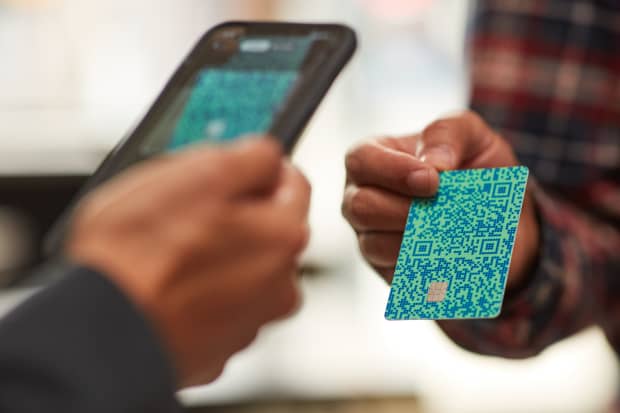

Venmo is rolling out a credit card with a personal QR code that users can show friends when trying to split payments.
PayPal
Venmo’s new credit card, by design, is meant to appeal to a younger demographic than a flashier card like the Chase Sapphire or American Express Gold Card. But the card’s innovations when it comes to credit-card rewards could have a lasting effect across the industry — and the perks cardholders will see in the future, experts say.
As an app, PayPal-owned Venmo PYPL, -1.99% is already ubiquitous among young adults, said NerdWallet credit card expert Sara Rathner. They regularly use it to do everything from splitting the bill for dinner out to divvying up the monthly rent among roommates.
“You already have this captive audience, and the audience tends to be younger,” Rathner said. Younger consumers, she added, are more likely to be newer to credit.
“You are maybe just out of school, getting yourself established professionally, and also getting yourself established financially,” she said. “You might not have had credit cards before. It can be really hard to qualify for that first credit card. So this becomes an option for a consumer who’s looking to build their credit history.”
Given the younger demographic, as of now the Venmo Credit Card isn’t competing with the likes of Chase Sapphire JPM, -0.55% and Amex Gold AXP, -0.19%. Instead, it’s competing for space in shoppers’ wallets with debit cards, student credit cards and retail cards.
“Viewed through that lens, it’s not so much about the rewards, it’s more about the overall simplicity, budgeting, avoiding interest and fees, those seem to be the more dominant themes,” said Ted Rossman, industry analyst at CreditCards.com.
Another card Venmo is competing with however is the Apple Card AAPL, +0.07%. Venmo and Apple’s credit-card offerings share many similarities beyond the fact that both are attached to tech companies. Both cards are linked to mobile apps that include budgeting tools and other features that are targeted toward financial health and integrating into people’s lives.
Both of these card have taken unique approaches to cashback rewards. Venmo’s cashback rewards are personalized — automatically. The card will offer 3% cash back on purchases in the cardholder’s top monthly spending category and 2% back on the second largest category, and these will reset each month. All other purchases will fetch 1% cash back.
The top spending categories will automatically be determined by where a person shops most, unlike other credit cards that offer rotating categories of rewards. The cashback cardholders earn will be deposited into their Venmo accounts, and they can use the money to pay off other card balances, transfer it to their bank account, make online purchases or pay back friends.
Venmo is not the only company to offer credit-card rewards like these. Back in July, the HMBradley Credit Card, which is issued by Hatch Bank, debuted with the same method of automatically personalizing cashback rewards. That card, however, was only available to a small audience: You needed to have a bank account with fintech startup HMBradley and a high credit score. The Venmo credit card will eventually be available to all U.S. users.
Like Venmo, Apple’s rewards were centered on its app. But instead, the primary innovation with the Apple Card was daily rewards: Rather than waiting weeks or months for cashback to accrue, the Apple Card deposits it into a user’s account in real time. Users can treat that money like cash, or even pay friends with it through a Venmo-like feature.
“It’s interesting to see that some of the innovation happening is with cash back,” said Matt Schulz, chief credit analyst at LendingTree. “So many cards just come out with some shade of the same kind of offerings that we’ve seen over the years.”
As Schulz sees it, the new strategies with cashback that Venmo and Apple are ushering in could be a game-changer in much the same way that the Chase Sapphire Reserve was years ago.
“The whole Chase Sapphire Reserve phenomenon killed the myth that millennials wouldn’t be interested in credit cards,” Schulz said. “It was just a matter of appealing to what they were looking for. And in that case, it was it was experiences and cheap travel and stuff like that.”
As digital natives, Gen-Z may be more focused on how credit-card rewards are synced with the apps they already use. In that way, algorithmic, personalized rewards could provide the ease-of-use Gen-Z is searching for.
And because they’re getting access to these rewards early in their financial lives, they could carry those expectations down the road. Other card issuers then would likely begin offering their own versions of personalized rewards to cater to these shoppers.
“When you’re young you develop brand loyalty,” Rathner said. “And if there are features that you really love about a certain credit card, you’re definitely going to seek them out in the next credit card.”
Of course, the timing of Venmo’s new credit card could also be a factor in the route the company chose to take with its rewards program.
Many of the top-tier rewards programs are heavily focused on travel-related perks, such as free checked bags and extra points for travel purchases. In the wake of the downturn in travel caused by the coronavirus pandemic, some have shifted toward less flashy perks. The Chase Sapphire card, for instance, now lets users redeem points for groceries and dining out.
“It would be a very risky time to launch a travel card just because of all that’s going on with the pandemic and people’s appetite for travel,” Rossman said.